Thought Leadership Studio Podcast Episodes:
Mastering B2B PR with Michelle Garrett
Episode 76 - Strategies for Building Credibility and Thought Leadership: Insights from a Top PR Pro and Author
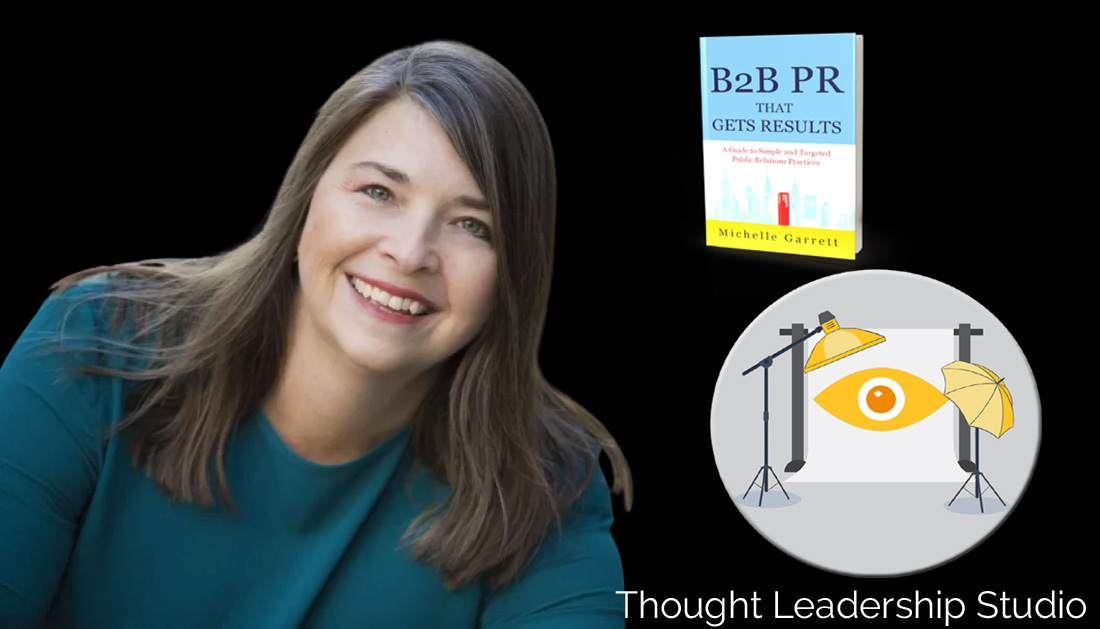
#authors, #b2bmarketing, #contentmarketing, #interviews, #pr, #thoughtleadership
Or Click here to listen or subscribe on appWhat this episode will do for you
:- Michelle Garrett’s PR Journey: Explore Michelle's extensive experience in the PR industry and her journey to becoming a top B2B PR consultant and author.
- Effective B2B PR Strategies: Learn the key strategies Michelle uses to help B2B companies build credibility and position themselves as thought leaders.
- Importance of Thought Leadership in PR: Understand how thought leadership content can enhance your PR efforts and distinguish your company from competitors.
- Utilizing Original Research: Gain insights into how conducting and promoting original research can capture media attention and strengthen your PR strategy.
- Collaborative PR Efforts: Understand the importance of client engagement and collaboration in achieving successful PR outcomes.
Michelle Garrett.
In this episode, I'm excited to introduce Michelle Garrett.
Michelle is a seasoned public relations consultant, writer, and speaker with a wealth of experience helping B2B companies craft compelling content, secure media coverage, and establish themselves as thought leaders. With a practical and down-to-earth approach, Michelle has consistently ranked among the top ten most influential PR professionals. Her latest book, "B2B PR that Gets Results," debuted as an Amazon Best Seller.
Michelle's career spans various roles in PR and marketing communications, including significant stints in Silicon Valley with tech giants like HP and Adobe, as well as numerous startups. She has written extensively for major publications like Entrepreneur and Ragan’s PR Daily and frequently speaks at high-profile events such as Content Marketing World.
In our conversation, Michelle delves into the critical role of PR within the marketing ecosystem. She explains how PR builds reputation and credibility, emphasizing that it differs significantly from advertising. Michelle highlights the importance of patience and the need to cultivate relationships with journalists to secure media coverage. She also discusses the power of thought leadership content and earned media in enhancing a company's credibility.
Join us as we explore Michelle's journey in PR and gain valuable insights into how B2B companies can effectively use PR to build their brand and enhance their market presence.
Some of Michelle's coordinates:
Curated Transcript of Interview with Michelle Garrett
The following partial transcript is lightly edited for clarity - the full interview is on audio. Click here to listen.
Chris McNeil: I'm Chris McNeil, your host of Thought Leadership Studio, and I'm sitting here across Zoom with author and PR Pro Michelle Garrett.
She's a public relations consultant, writer, and speaker who helps B2B companies create content, earn media coverage, and position themselves as thought leaders in their industries. She provides down to earth advice and a practical approach to PR for her clients repeatedly ranked among the top 10 most influential PR professionals. Michelle's new book, B2B PR that gets results debuted as an Amazon best seller.
Her articles and advice have been featured in publications, including entrepreneur in Reagan's PR Daily, and she frequently speaks at events like content marketing world. Welcome, Michelle.
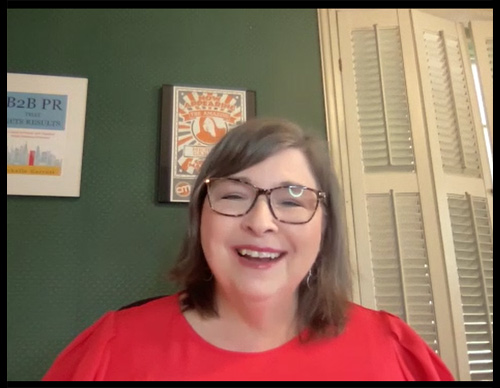 Michelle Garrett: Thank you so much for having me, Chris.
Michelle Garrett: Thank you so much for having me, Chris.
Chris McNeil: So one place we like to start, just to give our listener a little more context about where a guest is coming from ... What set you on this path to being a PR pro?
Was there a pivotal moment or a shift or a sudden light of awareness that sets you on this path that showed it was the right way for you and that you can make a difference like you are?
Michelle Garrett: Well, I mean, I think writing was the thing, the common thread throughout everything from the time I was very young, I just loved to write and I think I had to figure out, I was trying to figure out a way to work that into my career because I didn't necessarily want to be an author writing novels or something like that.
Not necessarily that kind of writing, but business writing and what kind of careers could I pursue beyond being a reporter or something like that. Which again, those are all great options, but I wanted a career that would incorporate writing, but allow me to do some other things as well. And I just landed in PR after some experimenting.
Chris McNeil: So how would you, that's also, by the way, and I love writing too, and I don't see myself as a author of long novels or anything, but I'm working on my first book, so I commend you on yours and we'll talk more about it in a minute.
Understanding the Importance of PR in Marketing
But in general, how do you see where PR fits into the ecosystem of marketing in general or public awareness in general, or companies promoting themselves in general?
Michelle Garrett: Yeah, there's a lot of confusion about what PR is. I think there's some mystery around it. People don't necessarily understand what it is, and when you try to explain what you do to people when you say you're in PR, I don't think they always understand.
So I like to think of it as definitely part of your marketing program. And it can be, it's really an essential part these days because your reputation is so important and just one wrong step can take down your reputation if you don't have it kind of built up and you have an audience and you have content and you have credibility, and you have all those things and PR can help you with all of those things and also can help you avoid a crisis and help you work through a crisis if you happen to find yourself in one. So I think it's an essential part of marketing, but I do think it's often overlooked and sometimes confused with advertising, which it is not.
Chris McNeil: What's the difference between PR and advertising?
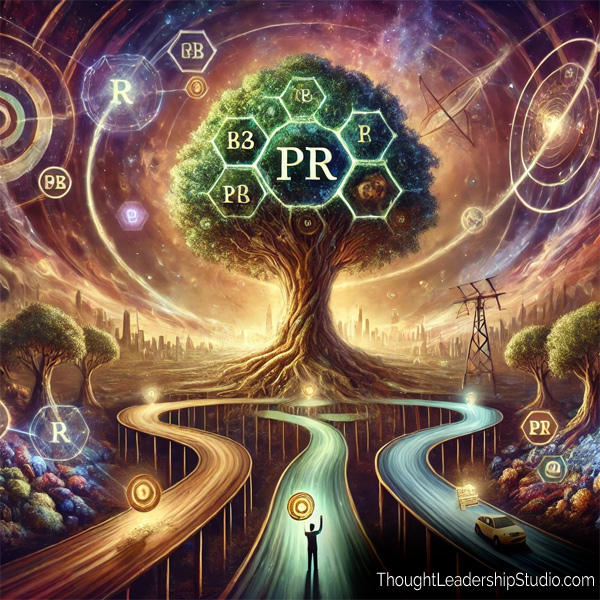 Michelle Garrett: Well, advertising would be paid, so you control the message. So if you're buying an ad or you're sponsoring a piece, and I'm not saying it's, I love my clients to do both actually, because really more powerful when you have earned media, which is PR and paid media, which is advertising.
Michelle Garrett: Well, advertising would be paid, so you control the message. So if you're buying an ad or you're sponsoring a piece, and I'm not saying it's, I love my clients to do both actually, because really more powerful when you have earned media, which is PR and paid media, which is advertising.
But to confuse the two and think that you're going to control, if you pitch a story to a reporter, you don't have control over what appears what day, what page, if you're in a printed publication or on a website or what, you don't know where it's going to show up and you don't know what it's going to say. Whereas with if you paid for it, you definitely would have more insight, more control over that.
Chris McNeil: Is that a common misunderstanding with clients? ... Where they want to apply that control to the earned media side, the PR side and have issues giving you the engagement or getting aligned behind a message and having maybe the patience for things to actually hit or not?
Why PR Isn’t as Simple as Sending a Press Release
Michelle Garrett: Yeah, there are a lot of issues. That's a really good question because patience is definitely one, because PR does take a while. That's what I always tell. If I talk to a prospective client and they say, well, we need this to show up in two weeks or whatever. I mean, we don't know N PR that we're going to be able to create that kind of turnaround, especially if the media doesn't know who they are.
So in that case I'd say, do the paid media route, go that route, pay for your ad or your sponsored contribution or whatever it is. So that's definitely an issue. Patients. And then I think sometimes too, clients don't understand that maybe they've only done paid media or ads and they think, oh, with PR we sent them the press release that we wrote, so it's going to show up just verbatim based on what we said at the press release.
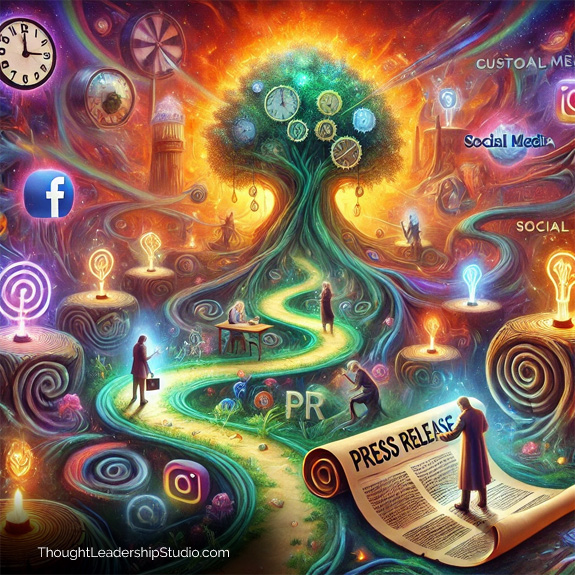 And that's not true either because the reporter will perhaps look at the release, then they'll go out and do their own research, they'll look at your website, they'll Google your company, they'll see what you're doing on social media, what other articles may have appeared, what people are saying. They might ask you for a customer reference or something like that. So it's not the clients can, I mean, if they don't understand how it works, it can be kind of scary because they don't know what's going to show up, and I don't think that they always trust in the process.
And that's not true either because the reporter will perhaps look at the release, then they'll go out and do their own research, they'll look at your website, they'll Google your company, they'll see what you're doing on social media, what other articles may have appeared, what people are saying. They might ask you for a customer reference or something like that. So it's not the clients can, I mean, if they don't understand how it works, it can be kind of scary because they don't know what's going to show up, and I don't think that they always trust in the process.
I think most journalists are not out to get anyone unless it's 60 minutes or, I mean, they're not all trying to zing you. They just want the truth and they want to know when they ask you a question, they just want an honest answer. So I think there are definitely ways to get ready for an interview. So you don't say anything that you would regret, but honestly, I wish that companies wouldn't overthink that part of it.
Chris McNeil: That makes sense. And do you find issues sometimes with clients who are used to the paid media side, having the empathy, seeing it from the eyes of the journalist and also the journalist audience?
... So maybe they don't get to that place where "let's come up with something that their audience would really appreciate" as opposed to "we'll just pay what it takes to get our message through"?
The Power of PR in Enhancing Company Credibility
Michelle Garrett: Well, the thing is, and I think this is important to emphasize, is that when you pay for it, people know that it's an ad and they know that the company is saying this about itself versus a reporter saying something about the company, which I mean, it could be more credible.
That's the idea behind PR, is that if a reporter chooses to write about your company, hopefully that would add to your credibility and it would be a lot you would never probably send out, if you paid for an ad or paid for a sponsored piece or something, you wouldn't send that out to your prospective customers and say, Hey, look at this. We paid for this ad. But if you got an article, right, if you got an article about your company in a trade journal for example, you might send that out.
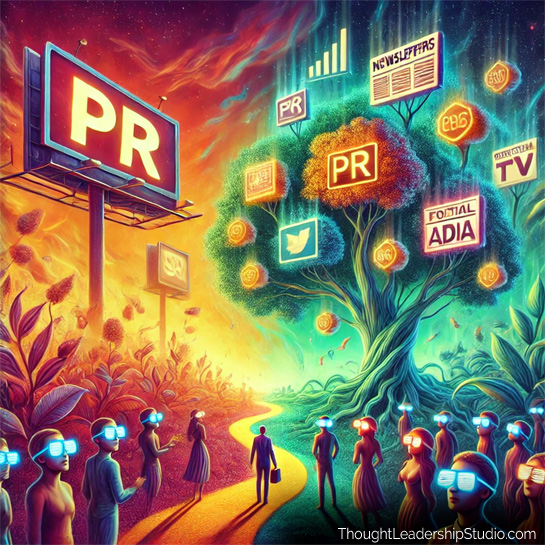 I mean, I would say that you should put it in your newsletter, you should put it on your website. Really, you should put it on social media. You should promote it once it's out there. So to me, there's a big difference in that part of it. And I think especially with younger buyers, I think the ads don't, they don't put any stock in that. I mean, they might see it, so it would create awareness that way, but they'd be like, okay, well, I'm going to do some research to find out if this company is really all that they say they are.
I mean, I would say that you should put it in your newsletter, you should put it on your website. Really, you should put it on social media. You should promote it once it's out there. So to me, there's a big difference in that part of it. And I think especially with younger buyers, I think the ads don't, they don't put any stock in that. I mean, they might see it, so it would create awareness that way, but they'd be like, okay, well, I'm going to do some research to find out if this company is really all that they say they are.
Chris McNeil: Well, that's right. We put on our BS filter sunglasses as soon as we know somebody paid for that placement. You can see it in things like too, and Google search results, the organic ones, even if you place a bunch of ads above and people are way more likely to click on the earned placement for an organic link rather than the paid ad because it just puts that filter.
I personally experienced this. I'll share a little story with you and you can critique my approach, but in my prior life, I owned a chain of one-on-one fitness training studios, where I first applied the coaching things I do in business now. And we made the business, I think a large degree on RP. I sent a press release ... I was a big fan of Jay Abraham. I was a big fan of marketing consultant Jay Abraham at the time, and he recommended some things like doing tests for, and so I sent a press release to all the media in town, a little different for each one.
It wasn't that many at that time. This was in the early 2000's. So the internet wasn't really taking off yet. I said, we will do a six week free program to one journalist in print media, one journalist in radio, one journalist on TV to give you the opportunity to try out an really innovative fitness and lifestyle management program for the purpose of writing a story about. We got a huge response and ended up on the first page on the cover of a local alternative newspaper magazine and article singing our praises, and we hit our third year projections in the third month open.
And that they liked it so much, they wanted to do a barter and bring their whole staff in to train with us in exchange for advertising. So then we were giving up full page ads regularly, and you could add up all of those full page ads over years, and he wouldn't come close to equally what the PR had got being on the cover of that. So that was my early exposure to the power of PR. I was won over.
Michelle Garrett: Yeah, it's great, isn't it? I mean, I love that story. It does speak to the powerful way that PR can play into your marketing and helping your business grow and get in front of people. I mean, if nobody knows about your business, I mean, nothing's going to happen, right? Nobody's going to buy anything and you're not going to grow and you're not going to. So I feel like it can be really powerful.
Chris McNeil: And is it the leverage of implied third party endorsement?
Michelle Garrett: Yes. Right. Yes.
The Evolution of PR: From Fax Machines to Digital Era
Chris McNeil: For sure. So how does it work these days? That was back before there was much of an internet, although we got some mileage through the internet later, but the days are different now when we have bloggers and podcasts like this one and all these other avenues. How is PR different from the way it was in the ancient ye olden days of PR via fax machines?
Michelle Garrett: Well, I started out, I remember those days I started, not to date myself, but I remember when we would take the giant media directories, they were giant books. You had to go to the library if you didn't work at an agency that owned a set and look up physically, look up reporters, and of course you know how out of date that was. So by the time you got it, it probably wasn't even the real thing. So there was a lot more to it I think, that way. But in a way, I miss those days.
 People actually had to do their homework, their research, and now we're kind of in a time when, I'm not going to point fingers, but a lot of times you will hire someone, an agency for example, and they'll pay for a subscription to a media database and they'll just literally spam out the same press release or pitch to thousands, hundreds, or thousands of reporters.
People actually had to do their homework, their research, and now we're kind of in a time when, I'm not going to point fingers, but a lot of times you will hire someone, an agency for example, and they'll pay for a subscription to a media database and they'll just literally spam out the same press release or pitch to thousands, hundreds, or thousands of reporters.
And this really turns off the reporters because obviously they didn't do any research, they didn't personalize the pitch. It's like shot in the dark. It's just shooting it out into crossing your fingers. I hope we call it spray and pray is what we call it.
Chris McNeil: Haha - right...
Michelle Garrett: So it doesn't work, but people continue to do it and journalists are fed up, honestly, they're just tired getting, I think there's statistics. I mean, floating around, the one that I hear most often is six PR people. For every reporter the way media outlets are shuttering these days and laying off journalists, it might be higher.
And then they're getting pitched by link builders like SEO link builder folks, which that's not the same as PR either. I'm not saying you don't need SEO, I'm not saying you shouldn't do that too, but it's not the same because when you pitch a story for a company, you're not only after a link. Yes, you would like a link, but it's really more about what does the story say and how does it talk about the client or the company or whatever.
Chris McNeil: When you're initially meeting with the client and say, as someone who might be some of the people who are listening, who's looking to practice some thought leadership and make an impact in an industry or profession by maybe bringing a new perspective in that's fresh and coming just from them, that's empowering to the customer for the end user, and they don't know a lot about PR, how does that initial conversation go where you educate them and what points do you touch on?
... Because I think that'd be really helpful for our listeners to hear.
The Importance of Thought Leadership in PR Success
Michelle Garrett: Yeah, I mean, I want to make sure that the client understands what is and is not possible with PR or in media. And so I always ask, and this is a good point too, I always ask what they are bringing to the table specifically, do they have thought leaders? Because everyone, anyone could say they are a thought leader, but are they manufacturing companies that I like to work with often are sometimes 50 years old, 75 years old.
A lot of the leadership actually does have experience, deep experience in the industry, and they could be considered an influencer thought leader type of individual. And I'm not saying you have to have somebody who's been at the helm for 20 years or whatever.
I'm just saying you really have to consider what you are bringing to the table if you actually have people that have what could be considered industry-wide as thought leadership type of ideas. And I hate to say thought leadership thoughts, but you know what I mean?
Chris McNeil: I know what you mean.
Michelle Garrett: Thought leadership content. Because I think, again, anyone can say this, but then sometimes you start digging in a little bit and you're like, Hmm, yeah, okay, well what are you doing that's different from your competitors, from everybody else in the industry? What are you doing? What do you see coming up? What's down the line? How do you view, what's the economic outlook in your industry? What are you seeing? Those kinds of things.
 And then I also ask what customers they can bring to the table for us to work with, because I think customers lend a lot of credibility to your public relations story, and they also can speak on your behalf and they can talk about you so that you don't have to blow your own horn, although I don't think there's anything wrong. If you do have things to say that are positive about your company, you should certainly be saying them.
And then I also ask what customers they can bring to the table for us to work with, because I think customers lend a lot of credibility to your public relations story, and they also can speak on your behalf and they can talk about you so that you don't have to blow your own horn, although I don't think there's anything wrong. If you do have things to say that are positive about your company, you should certainly be saying them.
But I think you need additional pieces and parts in there. And then research, if you've done any original research on your industry, reporters love that too. So that's another thing, and something I'm harping on a lot right now is visuals, because a lot of companies, and this stuff isn't always, some of it's expensive, but it's worth investing if you can in high resolution photos of your product and action. For example, up to date, current headshots of your leadership team.
Of course, logos, if you have video, that can be great. So that can make a difference, I think when you're pitching stories. So I usually try to ask these questions as I'm talking with prospective clients, and it's not that they have to have everything on day one, but I like to know that they're going to be engaged and they're not just hiring meet and then they're just going to say, okay, go do your thing, and I'm never going to talk to them again. I think it needs to be a collaborative effort with them engaged.
Chris McNeil: Yeah, absolutely. And that's something that seems to come up in my own consulting work too, is I actually just created a four quadrant model to make it simple - where high engagement and low engagement is like the y axis and support versus no support is the x axis. Because I've seen in people who trying to do thought leadership content is that they oscillate: do a whole lot of work and maybe start to build an audience, but if they don't have support behind it, then when you get busy, that goes away or gets lessened because "oh, now clientele is full"...
... But then of course now they're not filling the top of the funnel, so to speak, so they'll go through this oscillation pattern or to get burned out. In my realm, we need high engagement as well as providing a lot of support so it can be consistent as well as well thought out and doesn't dig so deep into their own time. I imagine you might've worked with some people who've tried to do their own PR then realize they need some help and support.
What kind of gaps do you notice when you are interviewing or learning about a prospective client that has tried to do PR themselves and what you bring to the table to amplify what they do they couldn't do on their own?
Michelle Garrett: That's a good question. I think I see companies who do it in fits and starts. They do PR. They'll say, well, we wrote a press release, we put it on the wire, we didn't get any coverage, and so PR doesn't work.
***************************************
The transcript is lightly edited for clarity and is a partial transcript- the full interview is on audio. Click here to listen.
***************************************
Free Stuff and Offers Mentioned in Podcast
***************************************
***************************************